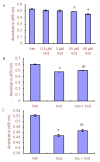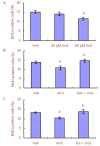Effect of midazolam on the proliferation of neural stem cells isolated from rat hippocampus
- PMID: 25657682
- PMCID: PMC4308778
- DOI: 10.3969/j.issn.1673-5374.2012.19.005
Effect of midazolam on the proliferation of neural stem cells isolated from rat hippocampus
Abstract
In many recent studies, the inhibitory transmitter gamma-aminobutyric acid has been shown to modulate the proliferation, differentiation and survival of neural stem cells. Most general anesthetics are partial or allosteric gamma-aminobutyric acid A receptor agonists, suggesting that general anesthetics could alter the behavior of neural stem cells. The neuroprotective efficacy of general anesthetics has been recognized for decades, but their effects on the proliferation of neural stem cells have received little attention. This study investigated the potential effect of midazolam, an extensively used general anesthetic and allosteric gamma-aminobutyric acid A receptor agonist, on the proliferation of neural stem cells in vitro and preliminarily explored the underlying mechanism. The proliferation of neural stem cells was tested using both Cell Counting Kit 8 and bromodeoxyuridine incorporation experiments. Cell distribution analysis was performed to describe changes in the cell cycle distribution in response to midazolam. Calcium imaging was employed to explore the molecular signaling pathways activated by midazolam. Midazolam (30-90 μM) decreased the proliferation of neural stem cells in vitro. Pretreatment with the gamma-aminobutyric acid A receptor antagonist bicuculline or Na-K-2Cl cotransport inhibitor furosemide partially rescued this inhibition. In addition, midazolam triggered a calcium influx into neural stem cells. The suppressive effect of midazolam on the proliferation of neural stem cells can be partly attributed to the activation of gamma-aminobutyric acid A receptor. The calcium influx triggered by midazolam may be a trigger factor leading to further downstream events.
Keywords: gamma-aminobutyric acid A receptor; general anesthetics; hippocampus; midazolam; nerve injury; neural regeneration; neural stem cells; proliferation.
Conflict of interest statement
Figures





Similar articles
-
The effects of etomidate and midazolam on adipose tissue-derived mesenchymal stem cell proliferation.Korean J Anesthesiol. 2016 Dec;69(6):614-618. doi: 10.4097/kjae.2016.69.6.614. Epub 2016 Sep 8. Korean J Anesthesiol. 2016. PMID: 27924203 Free PMC article.
-
Bumetanide, an inhibitor of cation-chloride cotransporter isoform 1, inhibits γ-aminobutyric acidergic excitatory actions and enhances sedative actions of midazolam in neonatal rats.Anesthesiology. 2013 Nov;119(5):1096-108. doi: 10.1097/ALN.0b013e31829e4b05. Anesthesiology. 2013. PMID: 23788048
-
The effect of prolonged anesthesia with isoflurane, propofol, dexmedetomidine, or ketamine on neural cell proliferation in the adult rat.Anesth Analg. 2008 Jun;106(6):1772-7. doi: 10.1213/ane.0b013e31816f2004. Anesth Analg. 2008. PMID: 18499608
-
Relationship between ketamine-induced developmental neurotoxicity and NMDA receptor-mediated calcium influx in neural stem cell-derived neurons.Neurotoxicology. 2017 May;60:254-259. doi: 10.1016/j.neuro.2016.04.015. Epub 2016 Apr 27. Neurotoxicology. 2017. PMID: 27132109 Review.
-
Immunopharmacological intervention for successful neural stem cell therapy: New perspectives in CNS neurogenesis and repair.Pharmacol Ther. 2014 Jan;141(1):21-31. doi: 10.1016/j.pharmthera.2013.08.001. Epub 2013 Aug 15. Pharmacol Ther. 2014. PMID: 23954656 Review.
Cited by
-
Research progress on the effects and mechanisms of anesthetics on neural stem cells.Ibrain. 2022 Nov 7;8(4):453-464. doi: 10.1002/ibra.12071. eCollection 2022 Winter. Ibrain. 2022. PMID: 37786590 Free PMC article. Review.
-
Effect of the volatile anesthetic agent isoflurane on lateral diffusion of cell membrane proteins.FEBS Open Bio. 2018 May 23;8(7):1127-1134. doi: 10.1002/2211-5463.12443. eCollection 2018 Jul. FEBS Open Bio. 2018. PMID: 29988595 Free PMC article.
-
In silico drug screening by using genome-wide association study data repurposed dabrafenib, an anti-melanoma drug, for Parkinson's disease.Hum Mol Genet. 2018 Nov 15;27(22):3974-3985. doi: 10.1093/hmg/ddy279. Hum Mol Genet. 2018. PMID: 30137437 Free PMC article.
-
The Effects of Anesthesia on Adult Hippocampal Neurogenesis.Front Neurosci. 2020 Oct 22;14:588356. doi: 10.3389/fnins.2020.588356. eCollection 2020. Front Neurosci. 2020. PMID: 33192273 Free PMC article.
References
-
- Zhao C, Deng W, Gage FH. Mechanisms and functional implications of adult neurogenesis. Cell. 2008;132(4):645–660. - PubMed
-
- Ge S, Pradhan DA, Ming GL, et al. GABA sets the tempo for activity-dependent adult neurogenesis. Trends Neurosci. 2007;30(1):1–8. - PubMed
-
- Andang M, Hjerling-Leffler J, Moliner A, et al. Histone H2AX-dependent GABA(A) receptor regulation of stem cell proliferation. Nature. 2008;451(7177):460–464. - PubMed
LinkOut - more resources
Full Text Sources
